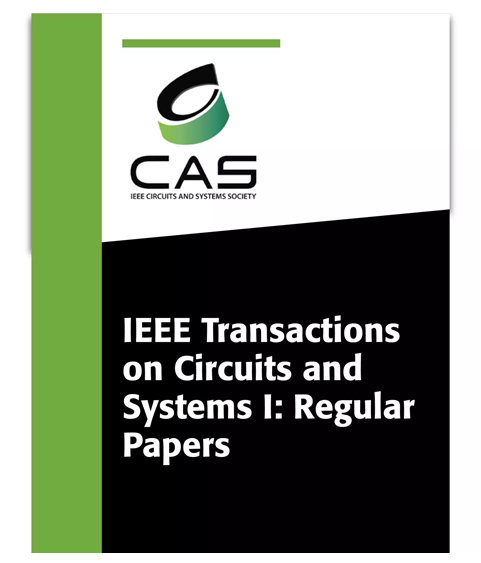基于铁电场效应效应的疾病诊断贝叶斯推理引擎
IF 5.2
1区 工程技术
Q1 ENGINEERING, ELECTRICAL & ELECTRONIC
IEEE Transactions on Circuits and Systems I: Regular Papers
Pub Date : 2025-02-05
DOI:10.1109/TCSI.2025.3533044
引用次数: 0
摘要
概率/随机计算构成了自主系统和分类器的主干。近年来,概率计算在生物医学领域的应用,如贝叶斯网络在疾病诊断、DNA测序等方面的应用,因其高能效而备受关注。贝叶斯推理被广泛用于基于独立(通常是相互冲突的)信息/证据来源的决策。异步电路元件的级联链或树结构称为穆勒c -单元可以有效地实现贝叶斯推理。这种电路利用随机比特流对输入概率进行编码,增强了电路的鲁棒性和容错性。然而,Muller C-element的CMOS实现体积庞大且耗电,这限制了它们在资源受限的物联网和移动设备(如无人机、机器人、太空漫游者等)中的广泛应用。在这项工作中,我们首次利用单个铁电场效应管提出了一种紧凑而节能的Muller C-element实现,并通过对威斯康星数据集进行高精度的贝叶斯推理,将其用于癌症诊断任务。所提出的实现利用fet独特的漏极-擦除、程序抑制和漏极-擦除抑制特性来产生作为铁电层极化状态的输出。我们利用内部开发的实验校准的紧凑FeFET模型进行了广泛的研究,结果表明,所提出的c -元件消耗(最坏情况下)4.1 fJ的能量和0.07~\mu m^{2}$的面积,并且在能效和足迹方面优于先前的实现,同时表现出相当的延迟。我们还提出了一种新的读电路,通过级联所提出的基于fet的c -元件网络来实现贝叶斯推理引擎,用于实际应用。此外,我们首次分析了随机输入比特流之间的相互关系对基于c元的贝叶斯推理实现精度的影响。本文章由计算机程序翻译,如有差异,请以英文原文为准。
Ferroelectric FET-Based Bayesian Inference Engine for Disease Diagnosis
Probabilistic/stochastic computations form the backbone of autonomous systems and classifiers. Recently, biomedical applications of probabilistic computing such as Bayesian networks for disease diagnosis, DNA sequencing, etc. have attracted significant attention owing to their high energy-efficiency. Bayesian inference is widely used for decision making based on independent (often conflicting) sources of information/evidence. A cascaded chain or tree structure of asynchronous circuit elements known as Muller C-elements can effectively implement Bayesian inference. Such circuits utilize stochastic bit streams to encode input probabilities which enhances their robustness and fault-tolerance. However, the CMOS implementations of Muller C-element are bulky and energy hungry which restricts their widespread application in resource constrained IoT and mobile devices such as UAVs, robots, space rovers, etc. In this work, for the first time, we propose a compact and energy-efficient implementation of Muller C-element utilizing a single Ferroelectric FET and use it for cancer diagnosis task by performing Bayesian inference with high accuracy on Wisconsin data set. The proposed implementation exploits the unique drain-erase, program inhibit and drain-erase inhibit characteristics of FeFETs to yield the output as the polarization-state of the ferroelectric layer. Our extensive investigation utilizing an in-house developed experimentally calibrated compact model of FeFET reveals that the proposed C-element consumes (worst-case) energy of 4.1 fJ and an area $0.07~\mu m^{2}$ and outperforms the prior implementations in terms of energy-efficiency and footprint while exhibiting a comparable delay. We also propose a novel read circuitry for realising a Bayesian inference engine by cascading a network of proposed FeFET-based C-elements for practical applications. Furthermore, for the first time, we analyze the impact of cross-correlation between the stochastic input bit streams on the accuracy of the C-element based Bayesian inference implementation.
求助全文
通过发布文献求助,成功后即可免费获取论文全文。
去求助
来源期刊
CiteScore
9.80
自引率
11.80%
发文量
441
审稿时长
2 months
期刊介绍:
TCAS I publishes regular papers in the field specified by the theory, analysis, design, and practical implementations of circuits, and the application of circuit techniques to systems and to signal processing. Included is the whole spectrum from basic scientific theory to industrial applications. The field of interest covered includes: - Circuits: Analog, Digital and Mixed Signal Circuits and Systems - Nonlinear Circuits and Systems, Integrated Sensors, MEMS and Systems on Chip, Nanoscale Circuits and Systems, Optoelectronic - Circuits and Systems, Power Electronics and Systems - Software for Analog-and-Logic Circuits and Systems - Control aspects of Circuits and Systems.

 求助内容:
求助内容: 应助结果提醒方式:
应助结果提醒方式:


